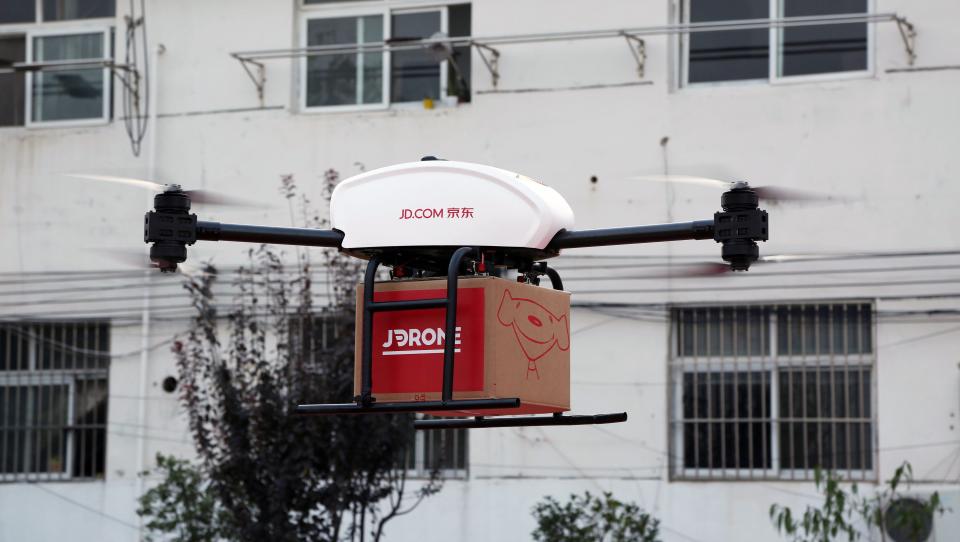Why Google teamed up with the Amazon of China
JD.com (JD), China’s second-largest online retailer, closed its 20-day annual shopping festival with record sales of 127.5 billion yuan ($20 billion) on the same day it announced a $550 million cash investment from Google (GOOGL, GOOG). Google will take a less than 1% stake in JD.com.
Google and JD.com will benefit from each other’s technology and valuable market access into the China and U.S. markets, according to analysts. The partnership will also allow both companies to compete in the global e-commerce space, currently dominated by Amazon and Alibaba.
The Amazon of China has logistics expertise

Founded in 1998, JD.com, with an Amazon-like business model, is a major Alibaba rival in China. JD.com owns more than half of the products sold on its platform, and uses efficient supply chain and logistics system to set itself apart. Same-day delivery has been available on the website since 2010. The company was once known for its labor-intensive last-mile delivery — employees ride an electric tricycle across cities and rural areas.
But it has been extensively investing in technology to change that image. JD.com has been testing drones and autonomous vehicles for last-mile delivery and operations to speed up sorting and to automate warehouses. And in November 2017, it launched an AI research initiative with Stanford University.
“JD’s own nationwide Chinese network is a huge differentiator between them and Alibaba’s Tmall. I think what they’re trying to do is to take that scale and ability to deliver products to not only China, but other markets as well,” said Danielle Bailey, head of Asia-Pacific research at consultancy L2.
Those experiences could help Google, as the internet giant eyes the booming e-commerce business. As Amazon emerges as a major destination of product searches and eats into Google’s ad revenue, Google has rolled out “Google Express,” a shopping hub where consumers can buy products from major retailers like Walmart and Target without a membership fee. Last week, Google teamed up with Carrefour to allow customers of the French grocery chain to shop online.
Google CEO Sundar Pichai said e-commerce is an area that the company has “tremendous interest” in and believes it could create flywheel effects when shopping is integrated into Google’s cloud and payments infrastructure. “I think you will see us make a lot more progress and have a lot more announcements,” said Pichai during last October’s earnings call. “And I think we are going to be relentlessly focused on making the buying experience much more seamless for users.”
Entering each other’s home market

JD.com has been aggressively expanding in Southeast Asia and Europe. Last year, it became the largest shareholder of Farfetch, a London-based luxury fashion online retailer. And in April, JD.com launched its Spanish website to target 400 million Spanish-speaking users. In the populous Southeast Asia region, it expanded by investing in local players in Thailand and Vietnam.
But the trade tension between Washington and Beijing is making it difficult for JD.com to enter the U.S. At the Davos Forum in January, JD.com CEO Richard Liu complained about protectionism against Chinese firms in the U.S. As part of the deal with Google, JD.com said it will select products to sell through Google Shopping in multiple regions, including the U.S.
Since Google’s major products and services like search are blocked by the Chinese government, investing in JD.com could be an opportunity for Google to penetrate China. A JD.com spokesperson said China is not an area they’ve discussed with Google yet, but “anything is possible in the future.”
“By partnering with a local provider, Google is trying to take advantage of the growing market without actually being in the market,” said Bailey of L2.
And this partnership may be just the beginning. “The investment in JD.com signals Google Retail 2.0 is on the way, which entails Google leveraging JD.com to provide customers with access to more products and a better last-mile delivery experience,” said Brittain Ladd, a retail and supply chain consultant, adding that more investments could follow.
Krystal Hu covers technology and economy for Yahoo Finance. Follow her on Twitter.
Read more:
ZTE, Huawei setbacks haven’t deterred Chinese smartphone makers from the US market
Why Americans aren’t using their phones to make payments in stores

 Yahoo Finance
Yahoo Finance 
